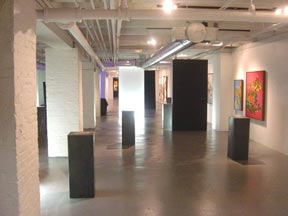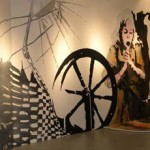Because it is the only gallery I can think of that gets its name from and quotes Michel Foucault in its mission statement, I wanted to know more about Space Other. I caught up with the “principal” of Space Other Gamaliel Herrera via email over the last week to understand its mission of “purposeful marginality” and get a sense of what to expect from this unique gallery. On view now is the third exhibition in its young history. Closer, which was reviewed in Issue #31, is up through December 31st. Of the many insightful thoughts published below, Gamaliel's insistence that “a modest and independent pursuit of finding connections in the tangle of art and discourse is something worth living for” resonated quite profoundly with me. Both “modest” and extremely ambitious, this project will hopefully give Boston something it lacks entirely: a true international gallery. Enjoy the interview.
MM: First off, can you tell me about how Space Other came to be, when it started, how it originated, where you come from, etc.?
GH: The idea to open a contemporary art venue in Boston (Space Other) arose as a way of negotiating several personal urgencies. First, there was/is a sense of need for engagement with the discourses that relate to the production of art, in an honest attempt to make sense (for myself, and hopefully for others through our work) of what seems to be a time of panic in the production of art.
Second, the project was a way of assuming a proactive role as a viewer and as an aspiring collector, by taking some responsibility for the work and the career of artists that I believe in. I started collecting contemporary art only very recently, basically after I got my first paycheck out of Radiology fellowship training at the Brigham and Women's Hospital. I am originally from San Juan Puerto Rico and moved to Boston in 2001 after living as a student in Madrid, Miami and New York. After a few years of traveling doing research, I realized that aside for the thrill of the hunt, the consumption and accumulation of objects was not, …it was the process that I was after.
Several friends were/are activators of this process of becoming behind the project, among them artists, architects, gallerists, curators, most of them based in Europe and New York. The ideas behind the works of Antoni Muntadas, Maurizio Cattelan, Thomas Hirshhorn –to name a few-, and the works of some contemporary thinkers have been illuminating.
The Space Other gallery opened on late May 2005. We have had three exhibitions so far. My partner Mark Schwindenhammer is the rock and doer of the space. Mark also introduced and takes care of a practical dimension within the venue, which is the events. We rent the space for private events. Mark is originally from the Chicago area and has over ten years of experience in the high end hospitality industry in Boston. From book signings to cocktail parties, these events keep the space alive and bring a crowd that perhaps would not experience contemporary art otherwise-and it is fun.
MM: I'm curious about your "purposefully marginal" institution. Can you talk about what makes Space Other marginal and why you feel it is advantageous to take such a position?
GH: “If wandering, considered as a state of detachment from every given point in space, is the conceptual opposite of attachment to any point, then the sociological form of the ‘stranger’ presents the synthesis, as it were, of both these properties. (This is another indication that spatial relations not only are determining conditions of relationships among men, but are also symbolic of those relationships.)”
Georg Simmel, The Stranger (1908)
Space Other is a modest, independent essay of a non white-cube art gallery operation. Reflecting upon the justification of such a "useless" project in late capitalism, the so called fifth dimension of spatial relations defined by Georg Simmel takes germane specificity. This dimension of spatial relations has to do with the now increasingly common phenomenon of changing of locations, such as by whole groups (e.g., nomadic tribes, Gaza residents, hurricane Katrina victims), individuals with particular functions (e.g., students, artists, business people) or travelers. The idea of “the stranger” or of “the other” as an identity for an art space emerges as a position optimal for activation, which mostly occurs at the margins. The margins or frontiers are where most traffic occurs, where there is exchange, where there is less chance for inbreeding, where there are pores that allow flux, generating a potential. Potential as an arena for intellectual as opposed to commercial exchange, eliciting unexpected perspectives from artists, curators and average Joes.
I believe that what makes Space Other marginal is most clearly understood by contrasting "geometric" with "metaphoric" space. “The stranger” or “the other” is both outside a group and confronting it. “The stranger” or “the other” is both mobile and fixed. He is geometrically in but not meaningfully of the group to which he is strange. This position of marginality is emphasized in an attempt to gain insight or provide a platform for engagement with the relationship between a geometric and metaphoric distance.
MM: It's interesting how the "other" or the "traveler" has become a model for contemporary artists. Miwon Kwon has written extensively on this. She presents a seemingly common scenario for artists these days, traveling from "site" to "site" doing projects and interacting with communities. The nomadic artist who creates interactions and "potential" is thus a new entity akin to the stanger I would presume. However, what inevitably happens is the, and I hesitate to use this word, reification of the artists efforts and the "movement" as a whole. In other words, the stranger becomes simply a new brand to be incorporated into late capitalism. With this in mind, how does an instituition remain in a position of "metaphoric distance" or ideological "strangeness"?
GH:“To the truer than true we will oppose the falser than false.”
-Jean Baudrillard
Micah, I agree with the observation that the archetype of the nomadic artist, a common practice today, is akin to the idea of the stranger, and that the reification or commodification of such artistic practices are a fact of our times. Space Other does not wish to spend energy claiming to have found subtle forms of radicalizing secret qualities or of resisting the forces of the market economy. These are challenging times of great velocities, when things find a way of avoiding meaning really quick. This loss of the dialectical may occur by mechanisms of senseless proliferation, speculation, seduction, ascention, you name it. Alas, the loss of integrity may tend to happen during practice.
I do not know that there is a static answer to the question about how does an instituition remain in a position of "metaphoric distance" or ideological "strangeness". I find that the process is one of constant examination and repositioning. For me, a modest and independent pursuit of finding connections in the tangle of art and discourse is something worth living for, strange enough. Nothing prevents us from assuming that we could obtain some insight by trying to look beyond mobility into metamorphosis, by doubting instant gratification and embracing challenge, by recognizing the fascinations of fashion, by resisting inertia in a hypersaturated environment.
MM: As far as programming goes, I understand your emphasis is on artists outside of the Boston area, artists locals would not normally see in this region. Can you talk about this decision and its potential impact not only for locals, but Boston's reputation as an art city abroad?
GH: A young artist and MIT graduate student told me a few weeks ago: “Boston is a B city with A traffic”. Is this right? Boston has some of the most influential and outreaching universities and businesses in the world, is this level sustained in the arts community? What is the reason for this discrepancy? Is there a need of activation to reach beyond provincial roots? In the past few years there has been a resurgence of Boston galleries participating in art fairs outside of Boston, is the flux equal in the opposite direction?
The focus of the Space Other program is showing the works of artists that have achieved a certain level and degree of recognition in their localities, but have not had the opportunity to show much abroad or in Boston – and that does not necessarily excludes Bostonians. So far we are working with artists and curators mostly from Germany, Latin America, New York City and the UK. Our next exhibition, from January 14th through February 25th (2006) will feature recent video, drawing and installation works by New York based artist Nayda Collazo-Llorens, with a text by Deborah Cullen, curator from El Museo del Barrio in New York. Hope to see you for the opening.
MM: The Miami Art Fair is this weekend, will you be attending? With so many biennials and fairs these days do you think there is danger in creating a parody of art production in every city?
GH: Yes, I'm leaving tomorrow to check out Art Basel and the NADA fairs in Miami, and meet with some people. There is a lot going on, and it is hard to keep up, forget about taking it all in. I believe this proliferation of temporary venues that you are refering to has to do in part with the popularity of the spectacle the fairs create, but also with cyclical market forces. The danger I see is in the loss of meaning that occurs with multiplication, which is an ubiquitous phenomenon of our time.
Links:
Space Other
All images are courtesy of the artist and Space Other







